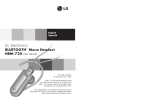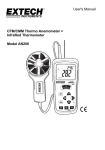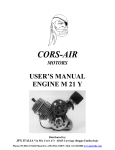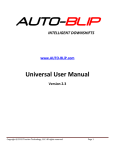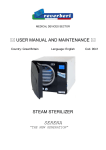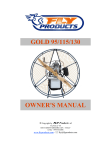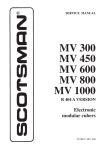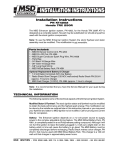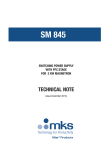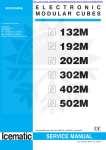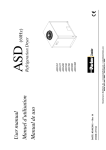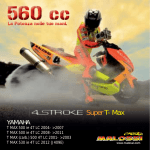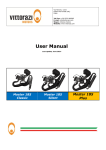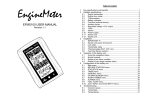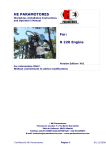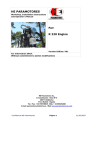Download CORS-AIR
Transcript
USER’S MANUAL for M19Y / BLACK MAGIC Distributed by: JPX ITALIA Production Plant: Via Falcone 4, 42021 Barco di Bibbiano (RE) Italy Phone:(39)0522-246544 Fax:(39) 0522-246169 www.jpxitalia.com e-mail [email protected] INTRODUCTION Thank you for choosing our engine, the CORS-AIR M19. Please, spend some time reading this manual, which will let you discover all the features of your engine. Advices on maintenance and operation will help you to have a reliable engine and to preserve your investment. We ask you to pass on the manual and all relevant documentation should you sell the engine so it can be useful for the next owner as well. Should you have any questions about the engine, please contact your local distributor who should be able to help you, a list of dealers can be found on our website www.jpxitalia.com YOUR SAFETY AND THE SAFETY OF THE PEOPLE AROUND YOU IS VERY IMPORTANT TOUS. IDENTIFICATION OF THE OWNER Owner:.. Address:.. Serial number:.. Reseller:.. Address:.. Owner’s signature:.. Reseller’s signature and stamp:.. Date of sale:.. Dealers Seal:.. The Company reserves the right to make technical and aesthetic changes without notice in order to improve the quality of the product. TECHNICAL FEATURES Engine M19 Cycle 2 strokes Total displacement 119,38 c.c. Bore 57,5 mm. Stroke 46 mm. Weight 10 kg without exhaust Complete exhaust 3,3 kg Peak RPM 9400 Cooling by free air Piston of light alloy with 2 piston rings of cast iron S10 cromium-plated Cylinder silicon light alloy with surfacing of Cermetal (NICASIL) Head special aluminium alloy Crankcase Cast alloy G-Al Si 9 UNI 3051 Carburettor membrane Feeding reed valve on the crankcase Electronic ignition type TCI Spark Plug NGK B9ES Starter manual Clutch centrifugal Reductor with Poly V belt Reduction 1:3,12 Continuous normal tempertaure Max 250 °C Exhaust pipe tuned Fuel unleaded gasoline 98 octane and oil at 2,5% Oil Good quality fully synthetic 2 stroke oil mixed with the fuel at 40:1 (2.5%) Engine suspension: Five rubber mounts (vibration insulators) MAIN TORQUES DECOMPRESSOR Cylinder head nuts M8 Nuts fo fix half crankcase Bolts to fix back support base to the crankcase Ignition magnetic wheel (flywheel) nut Gap between ignition coil and flywheel Kg.m (Nm) 1,9 19 2,2 22 2,5 25 2,0 20 3,5 35 min 0.35 mm, max 0.4 mm ENGINE MOUNTING: The engine should be installed onto the frame using 4 rubber mounts of 40mm diameter on the flange by the recoil starter and a 5th mount of 20mm diameter located on the underside of the engine next to the clutch. The use of the 5th mount is imperative to prevent engine damage during an eventual hard landing. PROPELLER: The propeller must be attached using M8 10/8 bolts with a plain shank. The bolt length must be of adequate length to ensure that the end of the bolt protrudes all the way through the reduction pulley and it must have sufficient length to ensure the prop can be tightened correctly without the bolts thread locking. The prop bolts should be torqued to 15Nm. If the propeller manufacturer specifies a different torque please, contact your dealer for further advice. Prop overhang must be kept to a minimum, and as a consequence, the use of props with separate hubs (such as ground adjustable props) is not recommended. Altering the loading on the engine by changing the prop, or adjusting the pitch can have affects on the fuel mixture. If a replacement prop is installed, the prop diameter altered or the pitch is adjusted, it will be necessary to carry out a check of the engine revs and re-adjust the carb mixture. THE ENGINE MUST NEVER BE STARTED WITHOUT A SUITABLE PROP INSTALLED. FUEL SYSTEM: The fuel system must be designed to ensure adequate fuel supply under all operating conditions. The engine demand may be as high as 8.5L/Hr and therefore the system must be capable of supplying at least 11L/Hr. From our experience, the hose should have minimum bore size of 5mm, and any fittings or filters must have a minimum bore of 4.5mm. A nylon or polyester mesh fuel filter with a fine mesh of 0.15mm must be installed in the line. Max total fuel line length is 800mm. AIR FILTER: A suitable air filter/air-box that does not restrict the airflow to the engine must be installed at all times. INSTRUMENTS: All engines should have a suitable Cylinder Head Temperature gauge fitted. We would also recommend installing an Exhaust Gas Temperature gauge. SECURITY: Mounting of the Air-box, exhaust system & air filter must be considered by the frame designer. Safety cables must be installed by the frame manufacturer to ensure that any parts that may come loose, can not enter the prop. Wire locking of the exhaust springs & exhaust manifold nuts is essential. FUEL: Use only fresh unleaded gasoline of minimum 98 Octane with a good quality fully synthetic 2 stroke oil. Mix the oil at a ratio of one part oil to 40 parts fuel (2.5%) (250 ml of oil per 10 l fuel). Ensure the fuel/oil is fully mixed in a separate container before filling up the fuel tank. Do not mix the fuel in the paramotor fuel tank. Always use a device (ie. a funnel) with a filter to transfer the fuel from the mixing can to the paramotor tank. PRE-FLIGHT CHECKS: It is the operator’s responsibility to ensure the serviceability of their engine prior to every flight. The following list is a guide of items to check, but it the pilot’s responsibility to thoroughly check the entire machine & engine prior to flight. Inspect all wiring and connections. Inspect engine for leaks. Check that all fasteners are tight or torqued to the specs. Ensure fuel system is free of leaks and the fuel filter is clean. Check propeller is secure, and undamaged. Ensure fuel tank vent is not blocked. Thoroughly check the exhaust system for cracks (WARNING – HOT PARTS). Check reduction drive belt condition & check tension (described further in this manual) Ensure that rubber mounts are in good condition and there are no signs of wear, cracks or separation. Remove plug cap, rotate engine and listen for unusual noises. Check reduction pulley bearings for play. Refit plug cap. Ensure correct operation of the throttle cable & ensure the movement is free & smooth. Check contents of fuel tank, and security of cap. Ensuring the area is clear of bystanders especially BEHIND and on the SIDES of the propeller. With the machine secure start the engine and warm the engine up below 2700 rpm until the CHT reaches 120C. Listen for unusual noises and abnormal vibrations. ADJUSTMENT OF THE CARBURETTOR The carburettor has two mixture adjustment screws, one marked “L” for adjusting low speed and one marked “H” for high speed. In order to make the adjustment, gently tighten clockwise until fully seated then unscrew: ” L “screw between 3/4 (three quarter) to one turn,” H” screw between 1 1/4 (one and a quarter) to 1 1/2 (one and a half) turn -adjustment with filter Air Box (Kart model), we advise this kind of air-filter. These adjustments can be different on the basis of weather conditions and flight altitudes. Ideal mixture is reached when the insulator of the spark plug is coffee brown; if the colour is black, the mixture is too rich, therefore turn screw H clockwise at 1/8 increments. If the spark plug is grey/white, the mixture is LEAN, therefore turn screw H and L counterclockwise always 1/8 at a time. Remember that if the mixture is too lean, THE PISTON CAN SEIZE or detonation may occur. A true colour can be obtained by running the engine flat out for 20 seconds at high rpm and then switching it off. Once you have found the perfect setting, do not change it unless you change the flight location, or climate conditions. RUNNING-IN FOR THE FIRST 20 HOURS: All CORS-AIR engines, before being delivered, are subject to a severe check, in order to ensure the highest possible quality. A GOOD RUNNING-IN WILL PROLONG THE LIFE OF YOUR ENGINE. Go to a quiet place, put a thick rubber carpet under your craft to avoid that stones or other debris could damage the propeller. Start the engine and let it work at 2500 rpm for 5 minutes, then accelerate speed to 3000/3500 rpm for 15 minutes, then increase engine speed to 4000 rpm for other 10 minutes. Ensure that the CHT does not exceed 250C during the running in process. Switch off the engine and thoroughly inspect it, including checking for leaks, loose fasteners, damage, cracks etc. BE CAREFUL NOT TO TOUCH HOT PARTS (POWER UNIT AND EXHAUST PIPE). Start the engine again and take it step by step to 4000 rpm for 5 minutes, then accelerate to 4500 rpm for 10 minutes. During the first 10 hours, the engine should be used conservatively and not subjected to excessive high power settings. High loads and prolonged high power settings will reduce the engine life & will increase the risk of failure. ATTENTION: this engine is free air cooled. The airflow generated by the propeller (and your airspeed in flight) are essential for the correct cooling of the engine. To obtain the best cooling, the cylinder on all Cors-Air engines is tilted to the side so the airflow will not be obstructed by the pilot’s back. Please, make sure that NO objects will restrict this flow (mount the reserve parachute overhead or on the opposite side of the cylinder). MAINTENANCE: After the first 1 hour running in (before flight): Carry out pre-flight inspection as detailed on page 5 Re-torque the propeller fasteners Re-torque the exhaust nuts Re-torque the cylinder head nuts Re-torque the spark plug Adjust the belt tension Every 20 hours: Check and clean the spark plug. Gap (0.7 mm) Clean the air-filter Replace the fuel filters Check the torque of every bolt Tighten head nuts (in cross order) with a torque wrench to 2.2 Kg.m (22Nm) Check the tension and condition of the reduction belt Check fuel lines and their connections Check the wiring Grease the exhaust ball joint with copper-grease suitable for high temperature Check the springs between the manifold and the exhaust Balance the propeller!!! Every 50 hours: Carry out the 20 Hr checks plus the following: Check the torque of the engine’s crankcase nuts Replace the spark plug Change the petals of the reed valve Check the reduction belt and the play in the bearings of the reduction pulley; replace if necessary Once a year (independently from flight hours and as preventive maintenance) change the diaphragm of the carburetor to avoid carburetor problems Every 150hrs: Carry out the 50Hr Checks plus the following: Remove the exhaust, cylinder head, cylinder & piston. Check the cylinder & piston. Inspect the piston pin & piston pin bearing. De-carbonize the engine Rebuild the engine with new gaskets. Nota Bene: It is advisable to keep records of all maintenance in a log book for the engine. TENSIONING OF THE REDUCTION BELT DRIVE - USE CAUTION!!! The belt tension will have to be adjusted during the first few hours of operation, and after each replacement. Care needs to be taken to ensure the correct adjustment as over tightening will cause damage to the reduction pulley bearings, shaft and possibly the crankshaft bearings. Before adjusting the belt take a marker and make a small line on the eccentric shaft of the big reduction pulley and on the front of the reduction plate. This is your Zero or starting point and from here, you will be able to clearly see how much you move the eccentric shaft of the big reduction pulley tensioning the belt in relation to the reduction plate. Remember “these are Fine adjustments” and we suggest not to rotate the shaft any more than 1 mm per adjustment. After each adjustment you can try to start the engine and check the result. The Belt tension ALWAYS increases automatically when the engine is running because of thermal expansion in the pulleys and crankcase. Once you have found the correct tension , do not adjust it any more. In case of doubts please contact your paramotor dealer – or JPX Italia. To adjust the belt, do the following: Loosen the safety bolt located high up behind the reduction mounting plate and the side bolt. Once these are loosened then you can turn the shaft with a 27 mm size wrench - carefully, to observe the 1 mm increments. Once you have finished turning the cam remember to re-tighten the safety bolts, first the back bolt, by keeping firm the cam with the wrench, and then the side bolt. Note: in order to get the correct results, it is imperative that the belt and pulleys are clean (free of black deposits in the grooves) and free of oil IGNITION: Should it be necessary to replace the coil or flywheel your engine will need to be returned to your dealer or an engineer with suitable training to carry out the work. The operation is not as simple as it would first appear. Incorrect fitting of the coil will alter the ignition timing and may cause permanent damage to your engine. The distance between the coil and the flywheel magnet is 0,40 mm. LONG TERM STORAGE OF THE ENGINE If you intend to store your engine for more than 3 months without use, carry out the following: Drain the fuel tank, including the fuel lines and the carburetor. Unscrew the spark plug and pour a teaspoon of 5ml of synthetic 2 stroke engine oil in the hole. Then re-install the spark plug letting the propeller turn slowly by hand for 2 or 3 complete turns. Disassemble the propeller, cover it and store it in a horizontal position. Loosen the reduction belt. Plug the hole of the exhaust pipe to prevent access of moisture. Cover everything with a blanket and put it in a dry place. Once a month turn the engine over by hand 2 or 3 times completely. BRINGING THE ENGINE OUT OF STORAGE: Prior to bringing an engine back into operation that has been stored for more than 6 months, a 50 Hr service should be carried out. Great care needs to be taken in inspecting all components for corrosion. WARRANTY: All CORS-AIR engines are manufactured with top-quality material and technology, therefore warranty is valid also for their accessories. DURATION OF WARRANTY: 1 YEAR beginning from the date of sell or exit from the JPX ITALIA Warranty includes spare parts and labour, transport costs are the responsibility of the end user. WARRANTY IS VOID IN THE FOLLOWING SITUATIONS Alterations to the engine not approved by JPX Italia. Normal Wear & tear of components Accidental falls or dropping of the engine or its components Overheating or seizure of the engine due to prolonged high speed running of the engine, incorrect setting of carburetor or insufficient lubrication by using low quality two stroke oil or inappropriate gas/oil mixtures. Running with excessive loads, Running with inadequate loads (running engine without propeller or propeller with too small pitch thus exceeding the max. RPM) Running with insufficient oil in the gasoline Incorrect tuning of the carburetor or running with no oil in gas The presence of dirt, sand or foreign bodies in the carburetor or the engine. Corrosion through poor storage of the engine or inadequate preparation for storage Running the engine without an air-filter fitted to the carburetor. Miss-assembly of engine parts or components not assembled by JPX Italia but by the paramotor manufacturer or by the end user, supplied disassembled for packing and transport purposes. Corrosion of the engine or components emanating from stone chips or any other impact or abnormal stress damage. Work other than standard maintenance set out in the product manual having been carried out on the engine by anyone other than JPX Italia or its official dealers. Incidental or consequential loss or damage. Service bulletins from JPX Italia not having been adhered to. Engine used for competitions. Please, contact JPX ITALIA or one of their dealers if there is anything contained in this manual that is unclear, or if you need any further information. TROUBLESHOOTING THE ENGINE DOES NOT START Check: On-off switch Cable of the spark plug Correct spark plug gap All electrical connections Fuel supply to the carb Check the tension of the reduction belt drive FLOODED ENGINE Remove the spark plug and dry it well ; before re-fitting it, pull the engine over several times ensuring the ignition switch is in the OFF position. THE ENGINE DOES NOT HOLD IDLE SPEED OR HAS AN IRREGULAR SPEED: Clean and adjust the carburetor. Check the reed valve petals for damage and ensure they are fully closed. Hold the reed up to a light and you should not see any light past the petal seating area. THE ENGINE CANNOT REACH MAXIMUM SPEED Check if the throttle is opening fully. Check that there is no dirt in the carburetor filter and there are no restrictions or air bubbles in the fuel line. Check all fuel hose connections are secure. Check the spark plug: if it is worn or has carbon build-up replace it. Check the gap and remember to replace the plug with the correct plug type & heat range. Check the connection between the high voltage cable and the spark plug cap; tighten the cap on this wire. If the connection is not tight, arcing may occur and this will affect the strength of the spark giving accelerating problems at low or max RPM and very hard starts. THE DECOMPRESSOR REMAINS BLOCKED: The most common symptom is a constantly worsening start. If you notice that in time you need more pulls in order to start the engine and/or you hear popping noises in the exhaust but the engine fails to start this may point (besides a reed valve, carburetor or electrical problem) to a partially stuck decompressor. Remove the decompressor & clean away any carbon deposits. Lubricate the stem with WD-40 or similar light lubricant. Reinstall decompressor torquing it to 20NM (2.0 Kg Meters) MAX. Do not overtorque because you will damage the threads in the cylinder. Before installation, on the threads of the decompressor, apply a thin coat of antiseize or Permatex non-hardening, high temperature gasket and flange sealant IF THE CLUTCH DOES NOT WORK SMOOTHLY Put 2-3 drops of oil inside the clutch bell. SOME FINAL ADVICE: NEVER switch on the engine with people near propeller, or to sides. The BREAKAGE of a propeller can cause very severe injuries even from several meters away. DO NOT keep engine at peak rpm after the take off, except when absolutely necessary (clearing obstacles) If you use big propellers, REMEMBER that cooling is less effective and it is the pilot’s responsibility to keep the engine temperature within limits (CHT gauge required) In addition, dismantle the propeller at regular intervals and check that it is perfectly balanced. A propeller that is even slightly out of balance creates microvibrations which even if not felt by the pilot, can cause serious damages to the engine and to the frame. Since the propeller has mass and a considerable inertial momentum, blipping the throttle is not recommended as it can cause all sorts of problems with the reduction drive system and crankshaft. Again, so it’s advisable not to vary suddenly the RPM of the engine, both in flight and on the ground. These sharp and violent stresses could cause damages to the reduction drive, the engine’s different other components. Once you have found the perfect carburation, DO NOT modify it unless there are significant changes in the climate, altitude, temperature or you change your propeller. Please visit the www.aerocorsair.com web site which on The Inventions Page, has many useful articles about maintenance and repairs of the Cors-Air engines. We wish you many happy flights with your newly purchased engine! The Cors-Air Team 1) CRANKCASE 2) HEAD 3) CYLINDER 4) PISTON COMPLETE OF PISTON-PIN AND LOCK 5) PISTON RINGS (N° 2 pcs. together with the piston) 6) BEARING OF DRIVE SHAFT (n° Pcs. 2) 7) CYLINDER GASKET 8) DECOMPRESSOR 9) COVER OF THE CRANKCASE 10) TIE-ROD FOR HALF CRANCKASE (n° Pcs.4) 11) TIE-ROD HEAD/CYLINDER (n° Pcs. 4) 12) BELT 13) HEAD GASKET 14) CRANKSHAFT COMPLETE OF CONNECTING ROD 15) CRANKSHAFT OIL SEALS (n° Pcs. 2) 16) NEEDLE BEARING 17) BACK SUPPORT BASE 18) STARTER 19) STARTER BASKET 20) FLYWHEEL 21) IGNITION COIL 22) REED VALVE 23) FLANGE FOR CARBURETTOR BED 24) CARBURETOR 25) AIR FILTER FLANGE 26) BIG REDUCTION PULLEY 27) BIG REDUCTION PULLEY ECCENTRIC SHAFT 28) CLUTCH BELL WITH SMALL REDUCTION PULLEY 29) BEARING OF REDUCTION PULLEY (n° Pcs. 2) 30) CLUTCH ASSEMBLY 31) BEARINGS OF CLUTCH BELL 32) CLUTCH SAFETY CLIP 33) NUT FIXING THE CLUTCH GROUP 34) SPACERS FOR BEARINGS OF THE CLUTCH BELL












